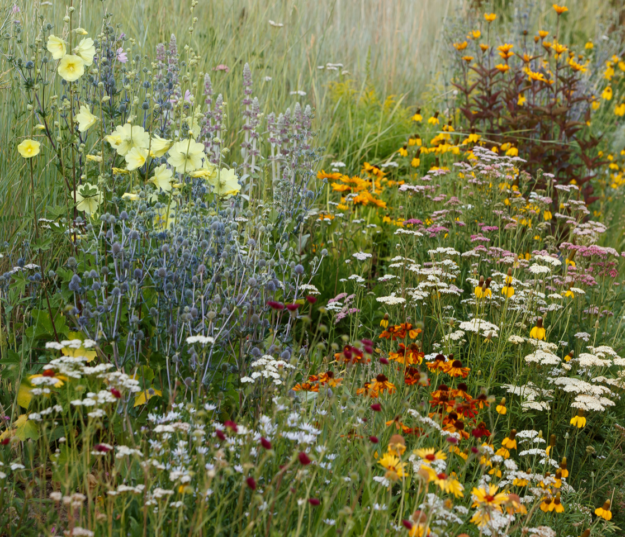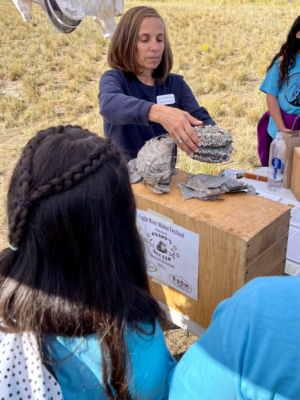Widgetized Section
Go to Admin » Appearance » Widgets » and move Gabfire Widget: Social into that MastheadOverlay zone
Vail to recognize June as National Pollinators Month in nod to Betty Ford Alpine Gardens

The Betty Ford Alpine Gardens on Thursday issued the following press release on the Vail Town Council recognizing via proclamation the month of June as National Pollinators Month:
On Tuesday, June 6, Vail Town Council will recognize with a proclamation the month of June as National Pollinators Month and give a local nod to Betty Ford Alpine Gardens’ efforts in educating the community and guests as to the growing importance of the relationship between pollinators and plants.
Garden experts point to current seasonal variations in climate, increased pollution and invasive non-native plants that are endangering the very insects and animals that transfer pollen among plants.
Turn to Nanette Kuich, education director at Betty Ford Alpine Gardens, to truly understand why pollinators are important to us and to the diversity of our environment. Betty Ford Alpine Gardens is an internationally-acclaimed, high-altitude botanic sanctuary known for its alpine horticulture, education and conservation. Located in Vail, Colo. at 8,200 feet, it is the highest elevation botanical garden in North America, and features a pollinator garden, a diverse mix of perennials, including blanket flower, sea holly, yarrow, hollyhock, Mexican hat and sneezeweed, attracting butterflies, bees and other insects.
“Here at the Gardens, we like to educate and promote the tremendous research that has been conducted around pollination, a critical process producing the fruits and vegetables we depend on,” says Kuich. “Factors related to climate change can be combatted by creating and maintaining healthy ecosystems.”
What can you do to help?
“Provide pollinators with food and shelter,” explains Kuich. “That’s where a garden full of flowers, preferably native, comes in. In addition, there is an advantage to you. Native plants we recommend are perennials because they come up year after year without you having to replant. Natives are important because the pollinators are adapted to the pollen and nectar they produce. Each flower has its own chemical factory.”
Kuich says shelter is important, as well.
“Bees will be looking for different places to lay their eggs for the next generation,” she says. “The female bumble bee, who overwintered in the ground, looks for an abandoned rodent hole to set up a small colony, and begins foraging. All other natives, who are solitary, hatch from the ground, wood or plant canes to collect pollen to feed their eggs and nectar to give them the food to go on.”
Kuich recommends leaving areas of bare ground for ground-dwelling bees who make up about 70 percent of the native species, stubble from the wildflowers at the end of the season for stem nesting bees, and snags and logs for carpenter and mason bees.
Colorado has almost 1,000 species of native bees, and 94 of them have been identified in Eagle County, according to Kuich.

“I like to emphasize all the other native bees that depend on native plants rather than non-native honeybees that are predominantly used for pollinating agricultural crops,” explains Kuich. “We are thrilled to be hosting a morning workshop on June 14 conducted by Carmen Weiland, Queen Bee of Honey Operations and Master Beekeeper at Edwards-based Knapp Ranch. Carmen will provide her expertise as to why bees are so important to our high-altitude environment, with hands-on learning for all ages and even a honey tasting.”
While bees are the most efficient pollinators – “Their little fuzzy bodies are meant to carry pollen,” says Kuich – the other pollinators that catch people’s eyes are beetles, flies, bats, hummingbirds – and butterflies.
“Painted Lady butterflies are some of the most well-known pollinators thriving in our mountain resort gardens – we don’t have monarchs here,” explains Nicola Ripley, executive director of Betty Ford Alpine Gardens. “We look forward to educating and inspiring all of our youth and adult visitors throughout the month of June on how to protect and support butterflies, bees, hummingbirds and other pollinators.”
Turning to plants
Most flowering plants need pollinators to reproduce, and pollinators need flowering plants for food. Flowering plants, remarkably, evolved about 125 million years ago. Plants quickly realized it was a lot more efficient to have animals carry male pollen to female flowers rather than depend on the wind. They developed a reward for pollinators, enticing them with sugar-rich nectar and protein-rich pollen.
“About 80 percent of the flowering plants in our area depend on animals to spread their pollen,” Kuich further explains.
Betty Ford Alpine Gardens’ 10 favorite plants for pollinators:
Spring
- Serviceberry – Amelenchier alnifolia – good wildlife food in fall
- Chokecherry – Prunus virginiana – also provides wildlife fruit
- Violet – Viola species – small, beautiful purple and yellow flowers
Summer
- Catmint – Nepeta – in the mint family, not native, but the bees love it, the deer hate it and it blooms all summer long
- Columbine – Aquilegia – bees like the purple ones, hummingbirds love the red ones
- Penstemon – Penstemon – largest genus of flowering plants in North America – a superfood for bees and host plant for caterpillars
- Yarrow – Achillea – easy to grow in hot dry conditions – nice landing pad for butterflies
- Geranium – Geranium richardsonii and nativars – easy to grow, spreads readily, leaves add fall color
How you can get involved and learn more:
Located next to the Gardens and Gore Creek in Ford Park, the Education Center features a variety of informational displays.
- Garden tours are underway: https://bettyfordalpinegardens.org/visit/
- Annual plant sale at the Betty Ford Alpine Gardens: members June 1; public June 2
- On June 6, 6 p.m., the Vail Town Council will recognize Betty Ford Alpine Gardens and their efforts to educate on the importance of pollinators with a proclamation
- On June 14, 10:30 a.m., the Queen Bee Carmen Weiland Workshop, at the Gardens’ Education Center
- During the month of June, Mighty Minnie, the Gardens’ pollinator ambassador, will conduct a pollinator scavenger hunt for kids of all ages
- Kuich recommends important information sources:
Xerces Society: https://www.xerces.org/
- Habitat Assessment Guide for Pollinators in Yards, Gardens & Parks includes a handy checklist: https://www.xerces.org/publications/habitat-assessment-guides/habitat-assessment-guide-for-pollinators-in-yards-gardens
- Attracting Native Pollinators – available through Storey Publishing: https://www.storey.com/books/attracting-native-pollinators/
- Pollinator Partnership: https://www.pollinator.org/
- Native Pollinator Recipe Cards – Intermountain Region
- Ecoregional Planting Guides – Southern Rocky Mountain Steppe
Fun facts:
- Butterflies aren’t the only pollinators. Pollinators you might find at the Betty Ford Alpine Gardens:
- Broad Tailed Hummingbird
- Rufous Hummingbird
- Bumble Bee
- Sweat Bee
- Mason Bee
- Leaf Cutter Bee
- Miner Bee
- Townsend’s Big Eared Bat
- Yellow Swallowtail Butterfly
- Blue Butterfly
- Sulphur Butterfly
- Painted Lady Butterfly
- White Lined Sphinx Moth
- Beefly
- Painted Ladies are the most widespread butterflies on the planet and they migrate through our area. It takes six generations to make it from Mexico to Canada.
- You have probably noticed the big yellow swallowtails, but, just like bees, you have to focus in on the incredibly beautiful world of the small butterflies. 139 species have been found in Eagle County.
- What butterflies need from us are the plants the eggs are laid on and caterpillars feed on. Painted Ladies, for instance, love thistles.
- With bumble bees, tongue length matters. Long-tongued bumble bees can find nectar hidden in flowers with deep tubes and spurs. Medium and short-tongued bees concentrate on more open flowers.


